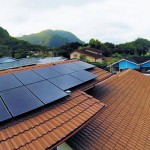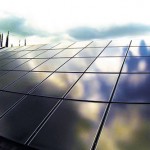Recognized for its lush beauty — as seen at Hoomaluhia Botanical Gardens and Kahana Valley State Park — as well as its magnificent views from sights such as the Koolau mountain range at Nuuanu Pali Lookout or Oahu’s No. 1 beach, Lanikai, the Windward side of Oahu is a wonderful place to live. Though with fewer peak sun hours than the rest of the island and frequent over-cast conditions, this pristine area along the east side of the Koolaus may seem less-than-ideal for installing a photovoltaic (PV) system. But with the introduction of Japan-made Solar Frontier CIS panels found exclusively at Risource Energy, Windward residents can now “see the light.”
The technology and design within the Copper Indium Selenium panels allows for optimum output in low-light conditions by capturing and converting solar energy even during morning hours, afternoon hours and overcast conditions.
PV is a huge investment and homeowners should make sure they are getting the most for their money in terms of dollar per watt. Distinct from other solar companies out there, Risource Energy offers homeowners a system that can still be efficient even in overcast conditions and keeps their electric bill low every month throughout the year. Customers will be pleased with a system and their savings from Risource Energy. Some Windward customers have seen their electric bills drop from $285 to practically nothing, saving nearly $3,400 a year. And with state and federal tax credits, they’ll be paying off their systems in three and a half years.
In an ideal PV system, one of its features should be that it can produce energy in the broadest range of environmental conditions. Darren Furumoto, director of operations at Risource Energy, knows that the climate in Hawaii can range anywhere from sunny to overcast, dry to wet, salty air to damp air. That’s why Furumoto wanted to offer Hawaii residents PV panels that can perform well in all types of conditions.
Another common type of low-light condition is caused by shadows, and Solar Frontier has managed to minimize this kind of power loss. Taking a look at the CIS panel, homeowners will notice it is comprised of 175 vertical lines versus other panels, which are comprised of a patchwork of squares. Because of this, when a shadow is cast on a portion of the CIS panel, it will not affect the output of the entire panel as it would on other patchwork-design panels. Furthermore, because the CIS panel is smaller in size, it allows for more flexibility in its orientation, overall design and wiring of a homeowner’s system when taking into account any type of rooftop shading like chimneys, vents, second-story structures or even nearby trees.
So don’t let less-than-ideal conditions dim your outlook on solar PV panels. Come find out what Risource Energy has to offer you, your home and your lifestyle. Call 843-8100 to schedule your free consultation.
RISOURCE ENERGY
contact // 843-8100
web // risourceenergy.com
email // inquiries@risourceenergy.com
See more articles from: Risource Energy


